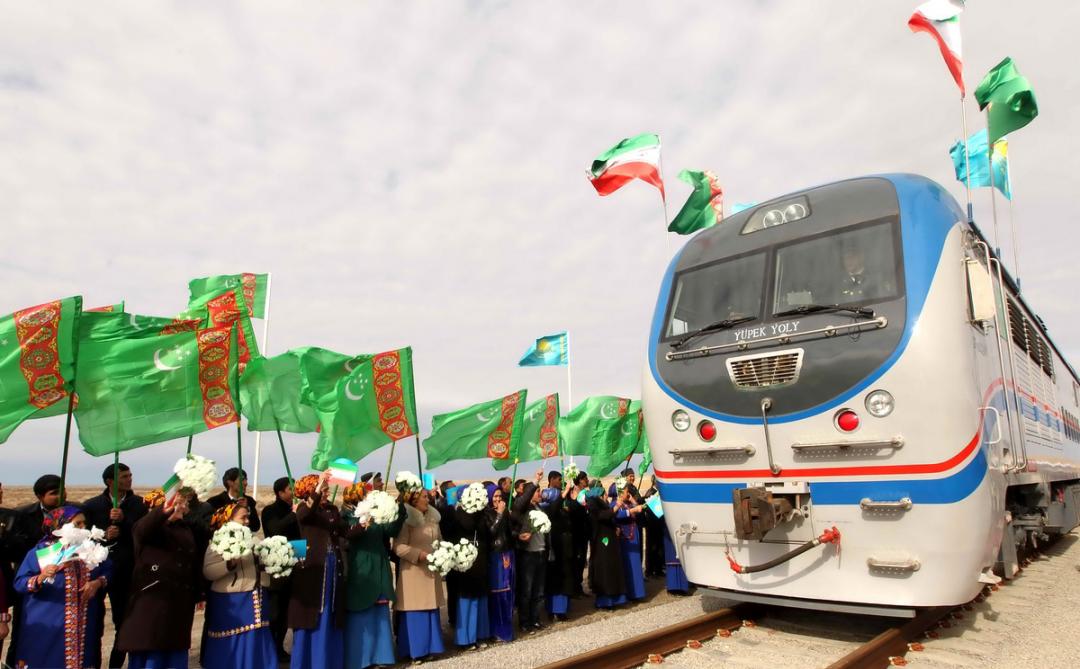The long-awaited transnational railway linking Central Asia with the Persian Gulf was officially inaugurated on Wednesday in a ceremony at a remote train station on the border of Iran and Turkmenistan.
The presidents of Iran, Turkmenistan and Kazakhstan attended the official opening of the railway in the Turkmen frontier village of Ak-Yayla.
In a speech at the cross-border station, Iran's President Hassan Rouhani said the opening of the North-South Transport Corridor represented a historic breakthrough that will benefit the region and beyond.
Describing the inauguration ceremony as "memorable and historic," Rouhani said, "The railway is aimed at facilitating transportation between the three countries and the whole region."
"Today is a happy day since all regional nations can now benefit from the corridor," Rouhani said, adding that the railway heralds a new chapter of better interaction among regional countries.
Rouhani further noted that the railway will make transportation of goods cheaper and economic cooperation more profitable.
The railway has the potential to transport millions of tons of commodities and thousands of passengers annually. This capacity according to the president will be increased in the future.
The railway connects Russia, China, Pakistan, Turkey and Iraq to the Persian Gulf and the Sea of Oman, the president said during his speech.
In his visit to the northeastern province of Golestan, bordering Turkmenistan, Rouhani was accompanied by Foreign Minister Mohammad Javad Zarif, Minister of Road and Urban Development Abbas Akhoundi, Interior Minister Abdolreza Rahmani Fazli, Vice President for Executive Affairs Mohammad Shariatmadari, and Secretary of the Free Zones Coordination Council Akbar Torkan.
Roads ministers from Azerbaijan, Turkmenistan, Oman, Kirgizstan, Kazakhstan, Uzbekistan, and Tajikistan also attended the inauguration ceremony.
>>>Corridor History
The corridor will shorten the distance between the Persian Gulf, Central Asia and Europe. It has been under construction since 2007 after Iran, Turkmenistan and Kazakhstan agreed to start working on the railway, which is 925 kilometers long in total, with 85 kilometers in Iran's territory, 700 in Turkmenistan and 140 in Kazakhstan.
It is estimated that initially three to five million metric tons of cargos per year will be transported via this route. In the long term the volume is set to increase to 10-12 million metric tons.
The project, which is yet to be fully completed, has been financed by the three governments as well as the Asian Development Bank (ADB) and the Islamic Development Bank (IDB).
The railway features 10kV overhead power lines, distribution and supervisory control, and data acquisition (SCADA) system which monitors and controls the trains operating on the entire rail system.
Most of the operations are controlled with the help of an automatic remote terminal unit (RTU) or by programmable logic controllers (PLCs).
Data acquisition includes meter readings and status reports which are compiled and formatted in a way required by the control room operator using the human machine interface (HMI). Based on the data the HMI decides, adjusts and controls the train operations. Data can also be saved in the database management system for auditing purposes.
The communication system involves installation and commissioning of the mobile train radio communication (MTRC) system.
>>>Comments
Iran's ambassador to Turkmenistan, Mohammad Mousa Hashemi Golpayegani, said on Wednesday that the launching of the North-South corridor is a turning point that is expected to boost regional economic activities, IRNA reported.
"Iran-Turkmenistan economic ties will undergo a sea of changes by the launch of the joint troika railway," he said in a meeting with the governor of the North Khorasan province.
He described the railway as "a milestone" that can transform the border provinces ties with Turkmenistan and other neighboring countries.
Kazakhstan's mineral reserves including iron ore, cooper, gold and chrome can also be transited though the corridor, said Hosseingholi Ghavanlou, the head of industry, mine and trade organization of Golestan province.
He said by the launch of the railway the province's annual handling capacity of cargo transit will drastically increase from its current rate of 500,000 tons per annum.
A day before the inauguration ceremony, Akbar Torkan said in a meeting with local officials in the Golestan province that the government is planning to turn Inche Boroun, the small town bordering Turkmenistan, into a free trade zone.
"Kazakhstan is home to rich mineral and mining resources which can be transferred to Inche Boroun through the railway," he said. "By turning Inche Boroun into a free trade zone, the region's economy will be transformed."
The Iranian official also expressed hope that the line would create an economic boom for the Golestan province.


